The main mistakes monetization of the application [and how to fix them]
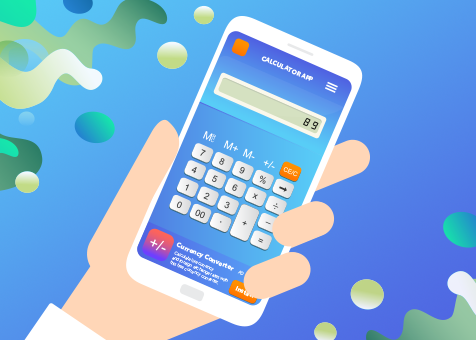
Today on the agenda are the constant rakes of mobile developers that I encounter during an application audit in Epom Apps - and this is more than 500 applications. For most mobile monetization errors, there are live examples and anti-examples.
But first - three recommendations from the cap, which you need to think about before the start of monetization.
Examine the target audience
Even if you think that the application is “for everyone”. It is necessary to take into account not only gender, age, geo, but also behavioral data (how users interact with applications).
Identify the core of the target audience The
best option in terms of monetization is not to work for a wide non-segmented audience, but for small target groups, which make it much easier to explain the value of your application.
Build value
When the target audience is defined - it's time to start developing a monetization strategy. The more benefits there are in the application, the higher the probability of finding users who want to pay for it (by subscription or installation).
Every mistake in monetization cost developers time, money and nerves.
Hopefully, after reading this article, the young developer will find many points of development of the application.
Error number 1 Random selection of advertising network
There are many ad networks on the market that provide traffic monetization services. The most common mistake at this stage is to start working with one ad grid like AdMob and not to test the rest. Different market players have different quality of traffic, analytics and advertising control capabilities: a couple of weeks of working with the advertising network are enough to understand its effectiveness.
Most often, developers choose an advertising grid solely on the basis of eCPM - an effective price per 1000 impressions. In practice, one eCPM is not enough to select the advertising grid.
Look at the Fill Rate - the ratio of the number of ad creative hits to the number of requests for its display. The higher the rate, the more effectively the advertising space is used. From the point of view of the developer, everything is simple - he wants to show ads ALWAYS when there is an opportunity, and the “simple” advertising space does not suit him due to the fact that the grid could not find a user who can show ads.
It is also necessary to take into account the types of creatives that will show (banners, native advertising, video, etc.), and the conditions for working with adverts. From the point of view of the publisher, it is more profitable to work on the CPM model and this scheme of work is suitable for adverts who unscrew advertising on large volumes. Small advertisers prefer to work on CPI, CPA, CPC and other models that involve payment for the target action of the user.
Ad networks that work with pay per result usually offer a high fill rate, but it’s not always profitable for publishers to work with them, because there is no guarantee of traffic monetization in this case - it all depends on how users behave and whether they want to interact with advertising .
Mistake number 2. Turn on the mode "All myself."
You can be a development genius, but it will not provide your application with top positions in the App Store or Google Play, users and a huge profit.
Sooner or later, you will have to think through the monetization strategy and it is advisable to do it not on the knee and not when the game is already running, but before the official release.
And it will be cool if at this stage you turn not only to the guys on the forum, but also to the pros. One two-hour consultation of an agency or a professional on mobile promotion can save from 30 to 60% of the advertising budget, and help lead users to a low CPI, ensuring a high retention rate.
And loyal users are much easier to monetize.
Mistake number 3. Incorrect monetization model.
Suppose you missed point 2 and decided to choose the appropriate model for monetization of the application.
At this stage it is important to remember not only about the advantages, but also about the disadvantages of each of them. Let's take it in order:
The freemium is the model that annoys users most of all with the fact that there are critically few useful and free features, but it offers “upgrade” to premium almost half an hour after installation.
When to use: If the application implies user involvement. And the user should have a cool experience even before you show him advertising. This model is suitable for those who have a large average session duration (more than 2 minutes) and a user base of 10,000 users. And most importantly - if the application can offer real value for an additional fee.
Subscriptions - the most difficult thing here is to understand how much free content you need to give the user before tactfully (or not) asking them to subscribe.
When to use: For news and entertainment applications (music, video), where a high retention rate is assumed.
An example of how NOT to do with subscriptions:
The Scribd book reader promised unlimited access to all books for those who paid $ 9 for a monthly subscription, but with a reservation in small print, that if you are a bookworm and read too much, it can cause damage companies that will limit your access. This led to an avalanche of negative comments:

Converting users into paid subscribers is not easy: the rating of the application is also important, a lot of mentions in the press and a good marketing plan, where the clear advantages of your application over others are clearly stated. Moreover, LTV of such users is not always higher than in other monetization models.
Shopping inside the app is suitable for games, retail attachments and utilities. In-app purchases are one of the most profitable monetization models. But there is a big risk of "random" purchases with the subsequent return of funds and bad reviews.
After the scandal with Tiny Zoo Friends, a game for children, where young users could easily make purchases within the app, and parents got into the money, Apple Store and Google Play adjusted the rules of the game and now application owners must make it clear when they have to pay for the app.

Mistake number 4. Wrong ad format.
Another super popular monetization model is in-app advertising. It is easy to implement and profit can be seen a week after launch.
The main problem of monetizing advertising is choosing the wrong metrics to track its effectiveness. You need to focus not only on eCPM, but also on the fill rate, the total number of hits, ARPU.
The two main mistakes in introducing advertising:
- Wrong choice of time and place for advertising: when advertising is shown before the application loads. When it interrupts the interaction with the application. And when it is simply illogical.

What to do: Set up analytics in Google Firebase or other platforms and track user paths.
- Irrelevant advertising: any distracting advertising that does not correlate with the theme of the application. In short, do not advertise online casinos in the application for children :)
Tip:
Rewarded Video still works well for shopping applications. For example, Get 13 as a bonus uses hints to players when they can not pass the level. The player watches the ads and plays on to the next deadlock. This allows you to show ads to the same user many times.
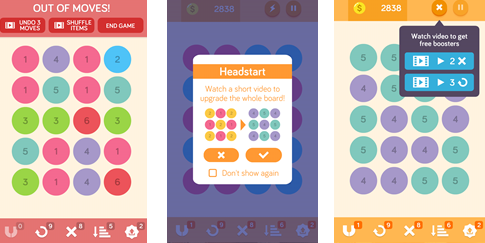
Visual best practices for rewarded for gaming and non-gaming applications.
Native advertising, as close as possible to the usual content in design, is no longer a luxury, but a necessity. According to Marketing Land , the share of native advertising will occupy 63% of the total advertising in 2020.
Mistake number 5 Cheating in ASO and cheap traffic
Despite the fact that only lazy did not say about the importance of ASO, there are developers who still want to deceive the system. In particular, put the number of downloads in the column “Developer's Name” on Google Play.
It looks like this: 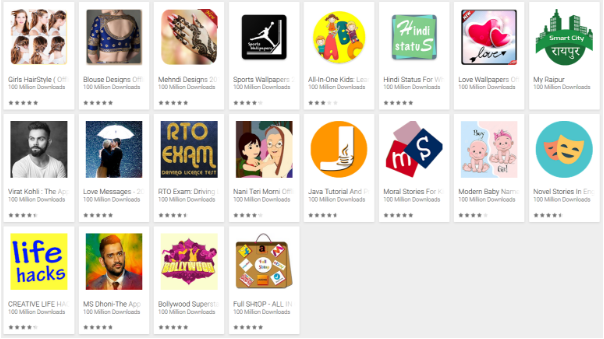
Developer, whose name is “100 Million Downloads”
The meaning is that the developer's name is displayed in the list of applications when searching, and "100 million downloads" add a new application of trust.
Cheap in-app traffic is a separate evil in promoting an application. Users are practically forced to install the application, and then "finish off" by advertising in it.

Users that you catch up in this way will be difficult to monetize. High Churn rate, bad reviews and a serious threat to the ban application - too high a price for attracting users.
Mistake number 6 unscaled monetization strategy
The monetization strategy should fit into the long-term strategy - along with the development of the application, the monetization opportunities should become greater.
Adding additional features for in-app purchases to the game should be logical.
The kings of monetization, of course, Angry Birds, which uses both paid access to new levels, and rewarded video, and banner:
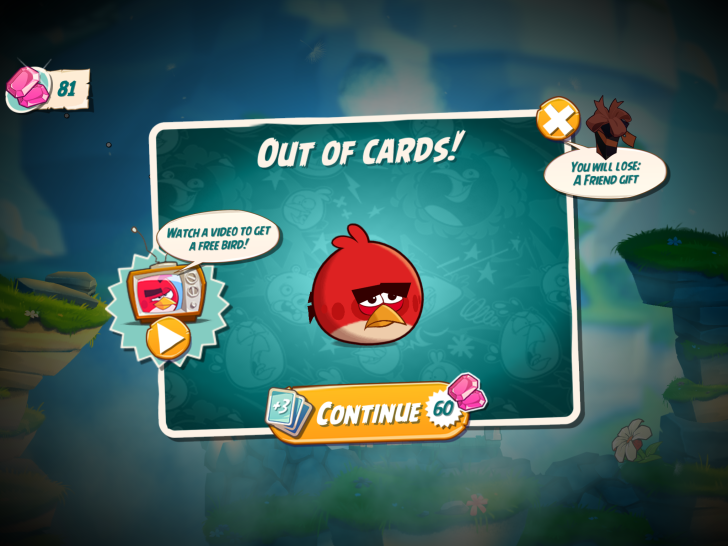
Focus on the user journey, analyze the duration of the sessions, retention DAU, MAU and form a strategy that would increase the involvement of the user (does not work for utility applications, pizza delivery services, taxi orders, etc.). The logic is simple: the longer the user is in the application, the more advertising he can show.
Error number 7 We do not segmented users
The game came out, a couple of publications wrote about it, in the first two weeks there was a lot of downloads, and then - silence. Familiar?
When the analyst “sags”, it is important not to optimize everything at once, but to understand which users to work with and which features to finish in order to get rid of little blood, and not to extinguish fires where there is none.
Segmenting users is important not only by geo, gender, but also by their behavior in the application and profiles. So you can not work with all users of the application, but with a pinpoint audience.
Example: The application for downloading files and music N in June of this year had 245,529 downloads. The main monetization model at that time was Freemium, where the first 30 days of using the application were free, and then offered to install an enhanced version of the application.
Of course, after expiration of the trial and installation of limits on download, the outflow of users was very impressive.
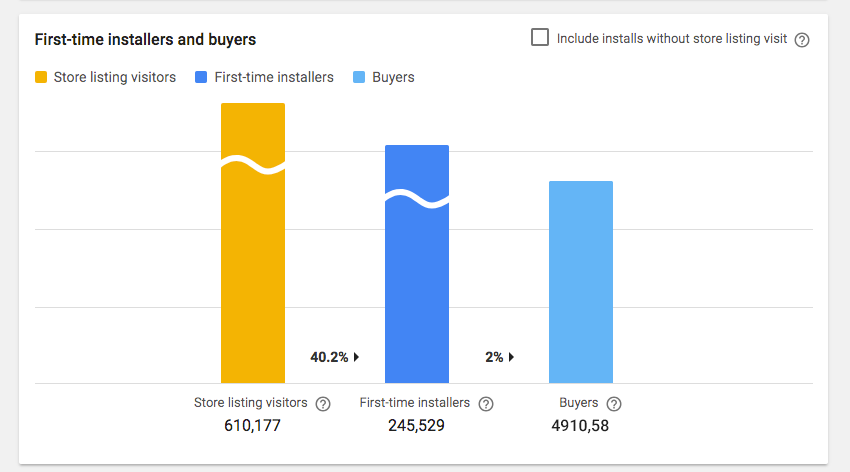
It turned out that 2% of users of the application are people aged 24-28 years (A), the remaining 70% are students 18-22 (B). Group A was ready to pay for a premium subscription.
Group B did not have enough basic functionality, but they were not ready to pay for the additional one, so after the month of trial they deleted the application.
Therefore, users of group B began to show advertising in exchange for an increase in limits on download, and users of A (who are already paying) do not show advertising.
I hope this article will save you from many errors in the monetization of the application. Is there a cool storyboard monetization of your application? Share in the comments!
